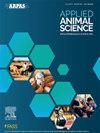In vitro and in situ estimation of ruminal and intestinal digestion of lobster and crab shell meal
IF 1.5
Q3 AGRICULTURE, DAIRY & ANIMAL SCIENCE
引用次数: 0
Abstract
Objective
This experiment compared in vitro dry matter digestibility (IVDMD), in vitro intestinal protein degradability, and in situ degradability of lobster shell meal (LM), crab shell meal (CM), soybean meal (SBM), and blood meal (BM), and chitin degradability of LM and CM.
Materials and methods
The 48-h IVDMD was determined in rumen fluid. For in situ DM and CP degradability, 4 Holstein cows were used to test the degradation rates of SBM, BM, LM, and CM. Samples were removed after 2, 4, 8, 12, 24, and 48 h. Protein fractions and degradation rates were determined. Fraction A was the washout before rumen suspension. Fraction C was the material remaining after 48 h. Fraction B was the initial sample − (A + C). The CP degradation rate was calculated by converting fraction B to the natural log and calculating the slope. The effective CP degradability was calculated by multiplying the sum of fractions A and B by the CP degradation rate and dividing that by the sum of the CP degradation rate and the outflow rate (2%, 5%, or 8%). For intestinal digestibility, Dacron bags (Ankom R510, pore size 50 μm, Ankom Technology) were removed from the rumen at 12 h, incubated with HCl and pepsin for 1 h, and then incubated for 12 h with protease and buffer to mimic intestinal digestion. After removal, sample bags were dried for 48 h at 55°C.
Results and Discussion
Soybean meal was more soluble than other feeds, and BM tended to be less soluble than LM or CM. Similarly, 12-h DM degradability was greater for SBM than for BM, LM, and CM; and BM was less than LM and CM. Intestinal DM digestibility was similar among feeds. Blood meal intestinal digestibility was estimated to be more than that of LM or CM. Rumendegradable protein was greater for SBM than for the other feeds. Blood meal was more degradable than LM and CM. Protein fraction A was similar for LM and CM, whereas fraction B and fractions A + B tended to be greater for CM than LM and fraction C tended to be greater for LM than CM. Soybean meal had greater fraction B and the sum of fractions A and B than the other feeds, and lesser fraction C. Degradation rates were greater for SBM than they were for the other feeds. Soluble chitin was greater for CM than LM, but degradability rates at 12 h and 48 h were similar.
Implications and applications
Results indicate that crustacean shell wastes may be used in cattle diets. More research should be conducted on feeding them to cattle.
虾蟹壳粉体外和原位瘤胃消化和肠道消化的研究
目的比较龙虾壳粕(LM)、蟹壳粕(CM)、豆粕(SBM)和血粉(BM)的体外干物质消化率(IVDMD)、体外肠道蛋白质降解率和原位降解率,以及LM和CM的几丁质降解率。材料与方法瘤胃液48 h IVDMD测定。在原位DM和CP降解率方面,选取4头荷斯坦奶牛,分别测定SBM、BM、LM和CM的降解率。样品在2、4、8、12、24和48小时后去除。测定蛋白质组分和降解率。分数A为瘤胃悬浮前的洗脱。分数C为48 h后剩余的材料。分数B为初始样品−(A + C)。通过将分数B转换为自然对数并计算斜率来计算CP降解率。CP的有效降解率是通过将组分A和B的总和乘以CP降解率,然后除以CP降解率和流出率(2%,5%或8%)的总和来计算的。为了观察肠道消化率,在12 h时从瘤胃中取出涤纶袋(Ankom R510,孔径50 μm, Ankom Technology),用盐酸和胃蛋白酶孵育1 h,然后用蛋白酶和缓冲液孵育12 h,模拟肠道消化。去除后,样品袋在55°C下干燥48小时。结果与讨论豆粕的可溶性高于其他饲料,豆粕的可溶性低于豆粕和豆粕。同样,SBM的12小时DM降解率高于BM、LM和CM;BM小于LM和CM。各饲料的肠道干物质消化率相似。血粉肠道消化率估计高于LM和CM。SBM的瘤胃可降解蛋白含量高于其他饲料。血粉比LM和CM更易降解。LM和CM的蛋白质含量A相似,而CM的蛋白质含量B和A + B的蛋白质含量往往高于LM,而C的蛋白质含量往往高于CM。豆粕中B组分和A、B组分之和高于其他饲料,c组分低于其他饲料。豆粕降解率高于其他饲料。可溶性几丁质在CM中的含量高于LM,但12 h和48 h的降解率相似。结果表明,甲壳类动物的壳类废弃物可用于牛的日粮中。应该对用它们喂牛进行更多的研究。
本文章由计算机程序翻译,如有差异,请以英文原文为准。
求助全文
约1分钟内获得全文
求助全文

 求助内容:
求助内容: 应助结果提醒方式:
应助结果提醒方式:


